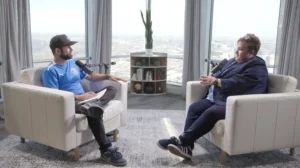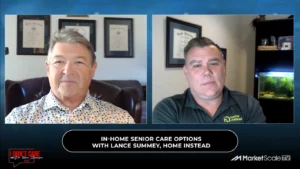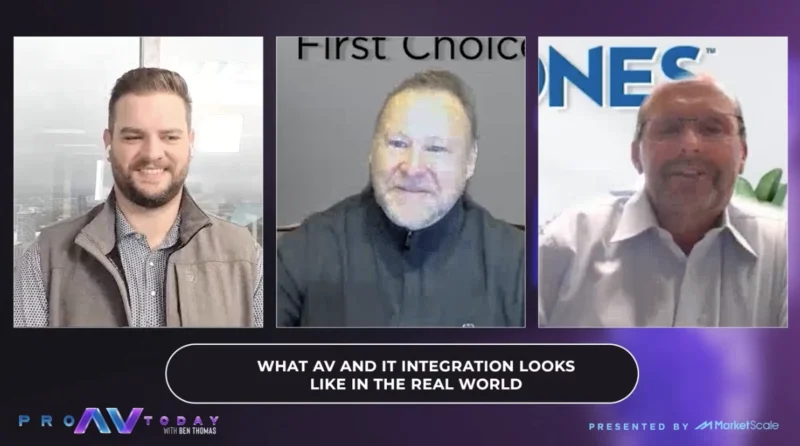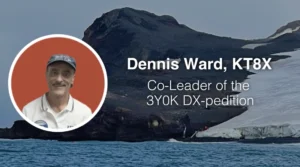Using LED Displays for Education and Revenue with Clint Burges of Nevco
Let me paint a mental image: summery Friday night, crowd cheering, stands full of fans, the sound of body-to-body impact. You probably guessed it by now; we’re talking high school football, a staple event in any sports-centric community. Maybe what doesn’t immediately come to mind is a multi-million dollar LED display showcasing highlights in slow-motion and illuminating the crowd with sponsors and promotions. This professional sports experience on a high school level is a reality now, and with this high quality technology comes amazing benefits and growing pains.
On this episode of the Pro AV podcast, we’re joined by Clint Burges, Senior Event Production and Onsite-Tech Manager for Nevco. After 11 years at Lamar University in Beaumont, TX, Burges knows the impact high school and collegiate football can have on an institution, both culturally and financially. “Curriculum directors are starting to realize there’s a lot of mitigating factors here that we can benefit a lot of areas, not just the football coach and not just the AD. We can benefit so much more within the community with it,” Burges said.
He comes on the podcast to break down the creative ways LED stadium displays are bringing communities closer together, bringing revenue to schools, giving students opportunities for CTE, and some of the difficulties in training local users on the full capacities of a rich, versatile LED screen. “Lot of these people, they don’t get to go to a Cowboys game or Spurs game or Pelicans game and see what’s out there. So they have to rely on us and they had to rely a little bit on what’s out in the real market to say ‘Hey, here are some things we want to do, you know, here’s what we want to do,’ and that’s where we come in to kind of assist that to say here’s how you do it,” Burges said. “Once that’s over with, you know, it’s up to you guys to sit down and actually repeat that process and get savvy on it.”
HIGHLIGHTS FROM THE EPISODE
Daniel Litwin: So bringing video displays into a game day atmosphere I feel like nowadays is pretty typical. You know, you see the overhead displays. Either they’re streaming the game or you’ve got some “cheer as loud as you can,” right, like just any mix of engaging the audience or zooming in and showing really detailed portions, replays. It’s part of the game day experience. If you don’t have it, it’s pretty archaic; but how are you seeing the evolved version of the video display sort of benefit some of these teams and some of these stadiums? You know, which teams and stadiums are you seeing adapting to new higher-quality video displays and how is that correlating directly to better experience, more fans, more engaged players?
Clint Burges: I don’t want to use the word segregate, but I kind of have to between high school and college a little bit. But I think, firstly, from a high school perspective, what you’re kind of seeing is probably about the prior five to maybe even eight years, you were really seeing a lot of IDs get involved and “we want it because these schools got it or that school got it.” Remember, I’m in Texas. So, you know, everything is bigger in Texas, but on the high school side, you know, you are seeing really…I think people from a high school side really started figuring out the bread and butter here relatively recently. A lot of institutions, especially in Texas started realizing that from a CTE (career technical education) perspective, there’s really a twofold to this, but from a CTE perspective, we can start utilizing the AV classes within the district to help run these video boards. Always a cost initiative there because again, still, they are having to pay somebody or it’s considered class credit. But on the flipside of that, what they’re also saying is that, again, if you can obtain hypothetically $10,000 in revenue or maybe $20,000, again, that numbers whatever, what’s happening is they’re kind of seeing a twofold here and what’s happening is it’s appeasing the curriculum side of things within the district. It’s appeasing the donors and the sponsors within the district to be able to have their ability to be up on the board. So a lot of high schools have in Texas and I can speak probably from the regionality as well, I have really sat down and seen that, “Look, we can utilize these kids, bring them in.” That gets them the opportunity to be in the classroom and get a hands-on experience, but on the same topic, we can actually go out and sell these sponsorships, get a little money for it, pay for itself and bring a unique fan experience to it. From the college side of it, you know, realistically speaking, being around, you know, again, a Division I institution for a while, it’s really becoming the norm and the reason being is because it makes your game day. It makes your atmosphere. It makes your fan engagement go up and make sure facilities environment go up. So there’s a — from a collegiate standpoint, there’s just a, you know, again, I guess, it’s becoming the norm is the best way to put that.
DL: Right. Well, I mean, and speaking personally from my experience in Texas because I’m also a Texas guy myself, I went to McKinney Boyd High School and—the entire McKinney sect which is just sort of suburb north of Dallas—they just got a multimillion dollar stadium put in place that has giant video screens on it and displays that are top-notch and professional level. So, I mean, you’re starting to set a precedent that even at the high school level, you’re getting professional video displays. You are getting a professional fan experience and I think it’s almost going to work its way from the bottom up like, “Okay, if high schools have this technology, what is a pro stadium going to bring to the table that’s pushing, you know, a new more authentic experience even more forward?”
CB: Well, you’re seeing this unique parity kind of accumulate I guess is the best say to say that, you know, but what you’re kind of seeing is again you’re starting to see forays and even now that we’ve got the success, you’re starting to see some of these smaller schools getting involved with it and that’s because, again, they’ve realized that they can let kids be involved with this. You know, Katy just opened a massive stadium over here outside of Houston. You’ve got McKinney. You’ve got Allen. Allen got some of these very, very large 20,000 seat, down here 20,000 seat stadiums; you’re seeing this kind of gap where a lot of the lower institutions in the Division I, there’s 347 Division I institutions and just, you know, for name sake, you know, Nevco, we’ve actually pulled in some of the swags that are in those lower markets and you’re starting to see those guys get really involved because there is a mass revenue opportunity. It’s a mass revenue opportunity. It engages your fans in so many outlooks of it, but these smaller schools, you start to see some of them get involved with it and the reason being is because again, they’re saying that we have an opportunity for revenue. We have an opportunity for the kids to get involved and really a bigger factor is a communal “a community factor” that a lot of the community goes…just case in point, just off the cuff here; I literally just followed somebody on Lufkin Panther Sports and they literally got an argument of whose video board was the biggest, I am sitting there and I am going, wow, they’re still having these conversations because they used to have it was who had the bigger stadium and who’s got the better jersey, and now it’s getting to the point well, who’s got the bigger video board? And that’s really what it’s boiling down to is a lot of these — these ADs, these suits, these school boards, you know, curriculum directors are starting to realize there’s a lot of mitigating factors here that we can benefit a lot of areas, not just the football coach and not just the AD. We can benefit so much more within the community with it.
DL: So let’s look to the technological side of things now. How have video displays in the athletics, whether it’s professional D1 sports or it’s high school athletics, how have they evolved and what kind of new features or optimization opportunities are being brought to the table, because I feel like we’re getting moments now where you want to toss up social media feeds on the big board and you want to show real time what people are tweeting? You know, how are you adapting to, you know, take information that is on a small scale blowing it up and also, you know, expanding the quality of cameras, expanding the resolution capabilities? What are you seeing coming through this market and how are things evolving?
CB: Well, you’re seeing from a display standpoint, displays are getting tighter and when we call them tighter, that means they are getting better mil, you know, the distance between the actual LED digital cell, but you’re seeing a lot tighter displays come into play. You know, when I got in the business 30, 32 mil was a great day and now you’re starting to see, you know, from a Nevco perspective, a 10 and a 6 is pretty traditional and they’re getting ready to make that migration here pretty quick to 6 and a 4. So you are starting — from that standpoint, you’re starting to see displays get tighter. What that means is there is more pixels on the board which means you can pump more of an HD signal to it so you get a much better image coming down the pipe. And that’s becoming cost-effective across the board, not just for us as a vendor, but also for everybody else. I think from an equipment standpoint, you’re seeing a lot of diversification of equipment across the board, everything from the high Gauss and Ross all the way down to the TriCaster’s and the basic clients that a lot of vendors have for the respective boards, you’re seeing a lot of that technology begin to migrate to more database, to more image-based, the clip servers, the clip servers, you know, you are going to able to play things out. You are going to be able to play music out. That’s not going to change. But you are beginning to see this change of how data plays a massive factor into it, how realistically like you just mentioned, how you are migrating social media into it. Not a lot of people were really using that social media aspect yet and they will when it starts trickling down. You know, we used it in our institution previously and we used it there and you can literally — you cannot even put the game up. You could leave that up to the entire game. The people were just sitting there taking selfies just to get up on the board. So that’s that fan engagement. That’s an environmental engagement that you want, but again from a technology perspective, as I kind of tell people all the time, producing shows or producing games, it doesn’t matter. Those things don’t change, which you may go to college for, which you may be on the job training for, those things don’t change. Your building blocks for show doesn’t change. It’s how you get there and that can be from the creative process. One of the technology processes as well, but you are starting to see again this unique kind of blend of how data is coming into it more, social media is coming into it more and you are starting to see technology kind of bend a little bit towards the display side a little bit. For years everything we had from it didn’t matter if it was Ross or it didn’t matter if it was router base. It didn’t matter. They were bending towards the broadcast side. Well, now the broadcast side is beginning to flip back a little bit towards the display side in my opinion because again, you are starting to see these schools have to do dual shows or they are utilizing equipment for killing two birds with one stone. So I think you’re seeing this unique kind of trend is beginning to kind of migrate things and I think things, as long as these boards begin to continue to get tighter, these boards begin to kind of get more cost efficient and more energy-efficient to a certain extent, I think you are going to see this trend continue to go. Will it all happen tomorrow? Probably not. Next week? Probably not, but down the road, absolutely. I think you – I think within a year or two, I think you are going to see some new technology come out that would be cutting edge so to speak.
DL: Yeah. Well, I mean, it sounds like it’s all providing positives, whether it’s a tighter display like you said more cost-efficient, more energy-efficient, but I wanted to know with these pushes in technology, are there any new difficulties in the installation or on the provider side, are there any new challenges that arise, whether it’s with getting new data on those boards, higher-quality video, whether it’s social media or maybe it has to do with those tighter resolutions? Any new issues?
CB: I am seeing, you know, from my perspective and I think from the smallest school you want to maybe the largest to a certain extent, I’m seeing staffing be somewhat of a problem and in conjunction with staffing, I think, I think the education side of it as well and the reason being is that you’re seeing a lot of institutions come in and say, you know, “Hey, we got this great board. It looks great and you know we provide all this training to go with you and give you everything,” but they haven’t been like some people ensure they go to Rockets games and watch what they’re doing and they don’t get to see those things. So what happens inevitably is they know they have got these, these great, you know, “Oh, we have got these great million on a board. It’s great,” whatever, but they don’t know how to get it up there. We do, you know, Nevco, we do a pretty good job of training and getting those guys to where need to be, but some of the things when we leave out the door, those are the things that has to be kind of continued and so we are seeing staffing in conjunction with just knowledgebase being something that I kind of see. I think the technology side, I think automation is going to be, you know, the lever of the future. Again, as I told you before, I don’t think it’s going to be “Alexa, cut the camera for everything,” but I think you get to the point where there would be some better automation whether it’s on switchers, whether it’s on data, whether it’s plug-and-play type situations. So I think those are going to begin to kind of change the game a little bit like we just mentioned, but I think for the short term, again, I think it’s really staffing and knowledgebase is really what I kind of see is coming up because this is all great stuff to have and it’s fun to play with this stuff. It’s unique to play with this stuff. Everybody wants to be the camera on the big board, but it’s finding those people, getting them engage, training them up, let them band your system, how you are running the show and then getting them down the road and in the same context, letting them understand that they have to continue their knowledgebase and how they are learning stuff within the show.
DL: Right. You know, it almost makes me think of the old adage. Give a man a fish and he eats for a day, but teach a man to fish and he will feed himself for life, like that kind of idea of okay, you can walk in as an installer and give these beautiful boards to a high school and then say, yeah, here’s kind of more or less how to use it and then leave and then honestly, maybe they will get some use out of it, but they won’t fully understand the capabilities or if whoever is staffing and running these boards on a consistent basis isn’t trained on all aspects of it or doesn’t really have time to dig in on their own time, then yeah, I could see that being a major issue. It’s a difficult thing because you don’t want to necessarily just say all right, we will give you this and now it’s your responsibility to learn how to use it. I think it needs to come from the pro-AV community itself.
For the latest news, videos, and podcasts in the Pro AV Industry, be sure to subscribe to our industry publication.
Follow us on social media for the latest updates in B2B!
Twitter – @ProAVMKSL
Facebook – facebook.com/marketscale
LinkedIn – linkedin.com/company/marketscale









